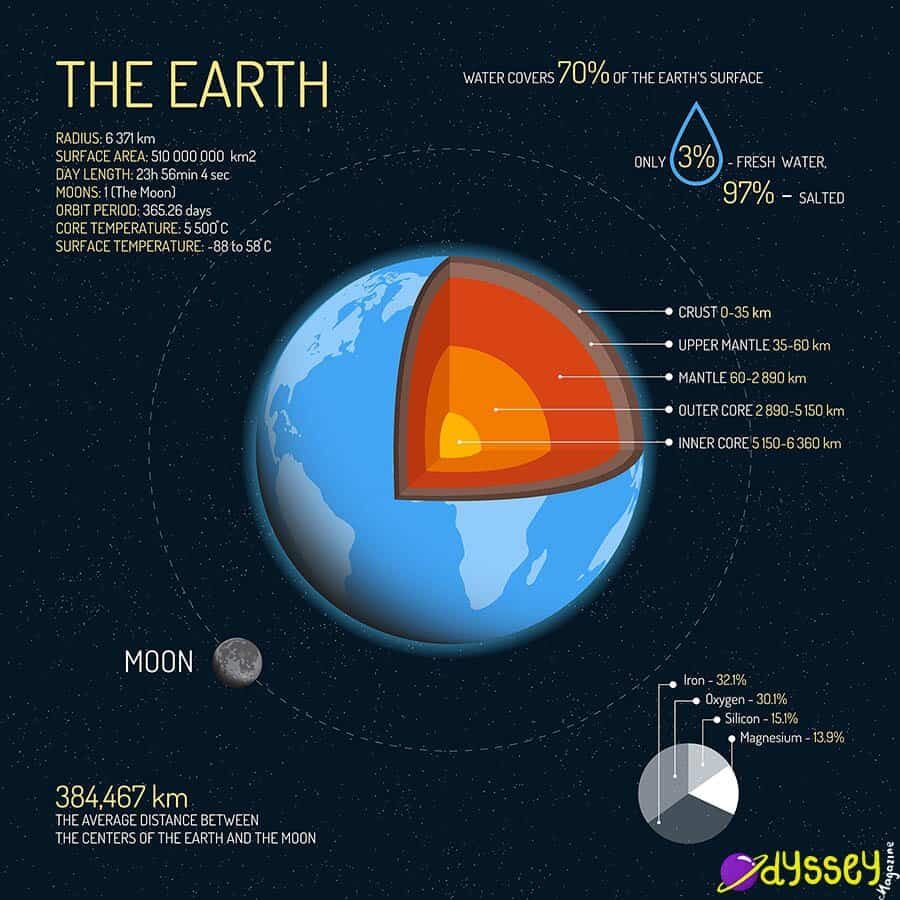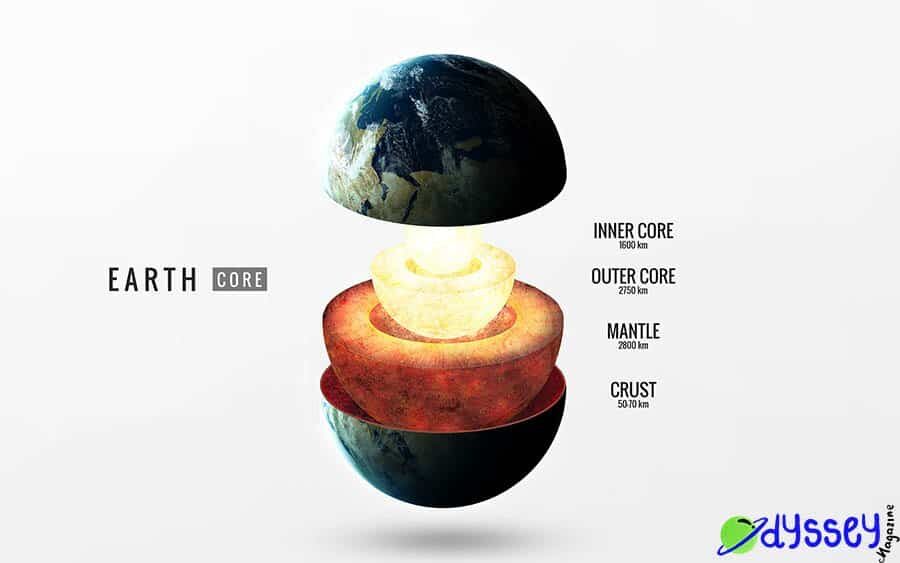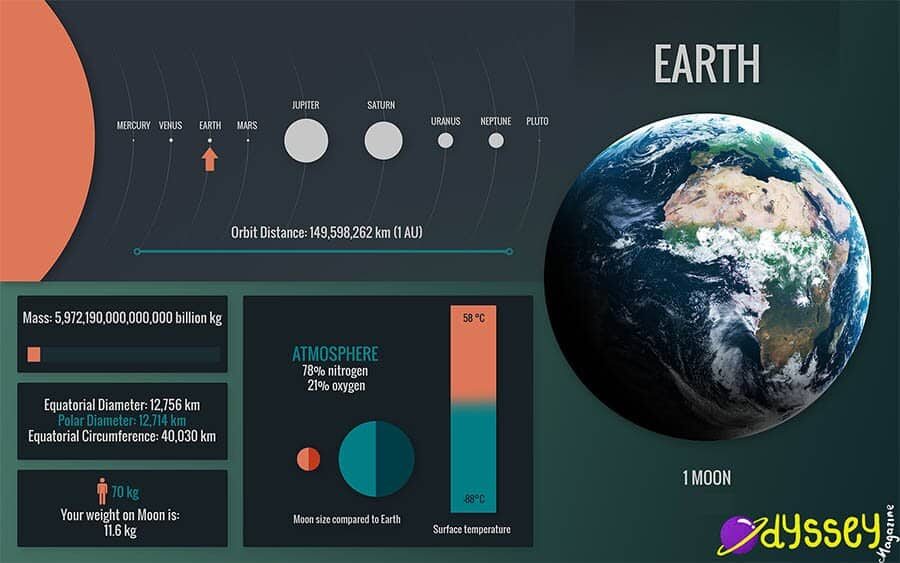23 Earth Facts | Fascinating Facts about the Planet Earth
We take our planet for granted. Though it doesn’t have the Rings of Saturn or the moons of Jupiter, it’s as intriguing and unique as of the others. People don’t tend to take as much interest in the Earth as other planets, probably because we’re living on it.

But the fact of the matter is that the Earth is an interesting as any other planet out there, if not more so! I mean, it’s the only planet that we know So, let’s take a look at some facts about the planet Earth.
- Earth is the third planet away from the Sun, behind Venus and Mercury.
- As you may know, Earth is the only object in our solar system that has life living on it.. that we know of!
- Earth is the fourth biggest planet, bigger than Mercury, Venus and almost double the size of Mars.
- Earth has a radius of 6371km, which is just under 4000 miles.
- As well as Jupiter, Saturn, Uranus and Neptune, The Sun is much bigger than Earth, as it has more than 100x the radius of Earth.
- Earth is roughly 150km (93 miles) away from the Sun, which varies depending on the point of orbit Earth is at.
- A full day on Earth is not actually 24 hours, it’s 23 hours, 56 minutes and 4 seconds. This is how long Earth takes to complete one full rotation, known as a sidereal day.
- As we know, a full year on Earth is 365 days. However, every four years we have to add an extra day called a leap year, because it actually takes 365.25 days for the Earth to orbit the Sun!
- The Earth travels around the Sun at a speed of 30km (18 miles) per second!
- Earth doesn’t move around the Sun in a typical circle fashion, it actually moves in an oval pattern.
The core of the Earth has interested scientists for thousands of years, and it’s made up of the inner core, outer core, mantle and the crust. In the very center, we have a large ball of mainly iron that’s a similar size to our moon. Outside of this, we have a fluid layer of molten iron, which is approximately 2750km thick.
Outside of the outer core we have the mantle, which is made up of silicate rock, which is primarily solid. This is divided into the inner mantle, the transition zone and the outer mantle. Then, we have the crust of the Earth, which is solid made up of rocks.

The Earth’s crust only actually makes up around 1% of it’s total volume, so it is relatively thin. The Earth’s crust and its outer mantle are referred to as the lithosphere.
The atmosphere on Earth is primarily made up of Nitrogen (78%), as well as Oxygen (21%) – there are also traces of argon and carbon dioxide, amongst other gases. The large percentage of Oxygen in the atmosphere is part of what allows life on Earth.

The atmosphere is the reason why we have varying weather changes throughout the year and variations across the planet. This is actually due to the lowest region of our atmosphere, which we call the troposphere. It is an estimated 75% of the entire mass of the atmosphere.
- Although we know a lot about Earth, there are still some things that we don’t know, as much of Earth has changed since the past, so it’s hard for us to determine how certain things began.
- Whilst most of the planets are named after Greek Gods, and Jupiter is named after the Roman equivalent of Zeus, Earth takes it’s name from the Germanic word for “ground”.
- Whilst Earth’s core is made up primarily of Iron, the surface is primarily covered with water (our oceans!).
- The average temperature on Earth is 15°c, which is good for us as it means it’s habitable! The hottest planet, Venus, has a temperature of more than 450°c in comparison.
- Our atmosphere is made up of primarily nitrogen and oxygen, with a small amount of argon and carbon dioxide.
- Earth’s mass is 5.972 × 10^24 kg. In figures, this is 5,972,190,000,000,000 BILLION kilograms!
- Of course, the Earth only has one Moon! It’s a race between Saturn and Jupiter to see who has the most Moons – currently it’s Saturn with 82, but there are more to be discovered!
- Earth doesn’t have any rings around it like Jupiter, Saturn, Uranus and Neptune do.
- There are more than 190 confirmed craters on Earth, which are caused by meteors and comets. The largest is the Vredefort crater, which has a 300km diameter.
- The most well known crater is probably Chicxulub, in Mexico. This is the crater that scientists think caused the dinosaurs to become extinct, as it’s collision with the Earth changed it’s temperature dramatically.
- Up until the 1500s, we thought that the Earth was the center of the universe. This only changed when mathematician and astronomer Copernicus showed us otherwise.
- It’s theorized that in the past, Earth actually had two moons. This was until the second moon collided with our known moon.
- Earth is the densest object in our entire solar system.
One of the most common questions about Earth is people wondering whether it’s in the Milky Way. The short answer is that yes, Earth is in our solar system, which is part of the Milky Way galaxy. The Milky Way is the 2nd largest Galaxy in the “Local Group”, which is what we call this group of Galaxies. It is smaller than the Andromeda Galaxy, and larger than the Triangulum Galaxy. However, it’s estimated that there are at least another 100 billion galaxies in our universe.
Although they are millions of miles away, you can actually see several different planets from Earth. The easiest to see is the planet Venus, as it is the closest to us and it’s the brightest object in the sky. You can also see Mercury, Mars, Jupiter and Saturn throughout the year, typically at either dusk or dawn.
Another common question is about the size of the moon, and whether it is bigger or smaller than Earth. The moon is quite a lot smaller than Earth, about a quarter of the size. The moon is still quite big in comparison to many other moons, as it’s the fifth biggest moon in our solar system. In terms of mass, the Earth is more than 80x that of the moon.
So, the universe first formed almost 14 billion years ago, with our solar system forming approximately 4.5 billion years ago. The Earth also formed at this time, essentially made up of tiny pieces of cosmic dust which come together to make a large sphere. Initially, the Earth was hot due to being hit by meteorites, but this eventually stopped. The surface cools, and the crust of the Earth forms into a solid rock. The inside of Earth is still hot liquid, which rises through the Earth’s crust. This causes steam, which in turn causes clouds and rain, which creates our oceans. The volcanos, now submerged by water, shoot magma to the surface, which forms our continents. The crust splits into the continents we have today.
The Earth’s makes one full rotation in just under 24 hours. This means that the surface of our Earth turns at around 1,000mph.
Planetary rings are made up from debris from either when a planet was forming, or from a collision that resulted in pieces and particles being scattered, eventually forming into a ring around the planet. Well, Earth cannot have an ice ring like the ice giants, as it’s far too close to the Sun. The other type of ring we could have had would be made up primarily of dirt and rocks. In fact, we may have had a ring in the past, but this was theoretically destroyed in a collision – the rocks and particles from our ring ended up forming our moon!
Hopefully these facts about the Earth have given you all the information that you need. Whilst we know so much about the Earth, there are still many things that we don’t know and are learning. If you have any cool facts about the Earth to add, leave them in a comment below!